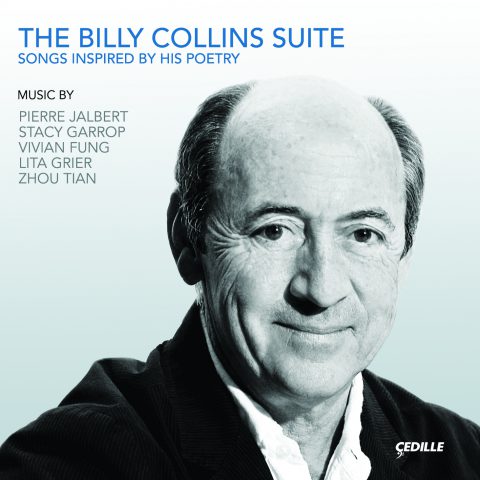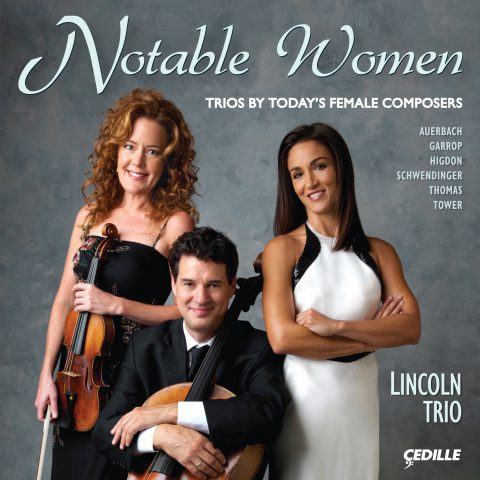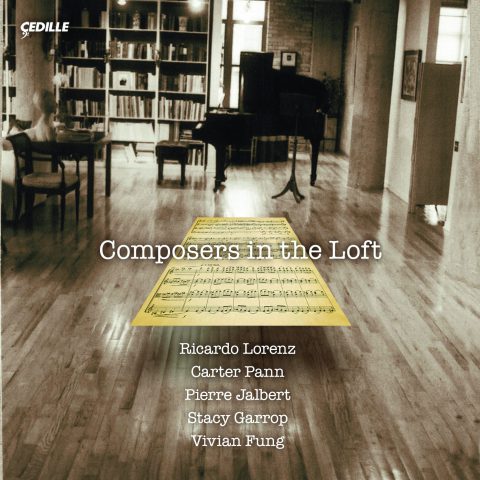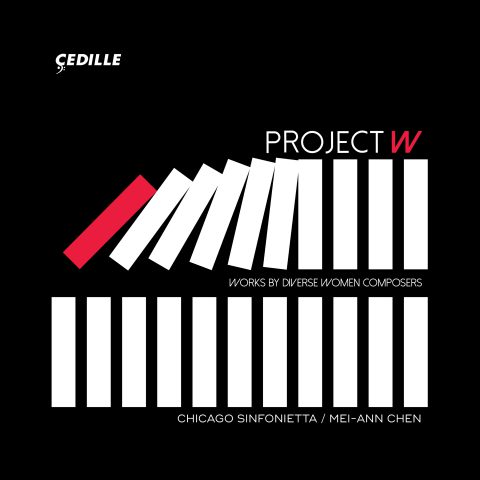Store
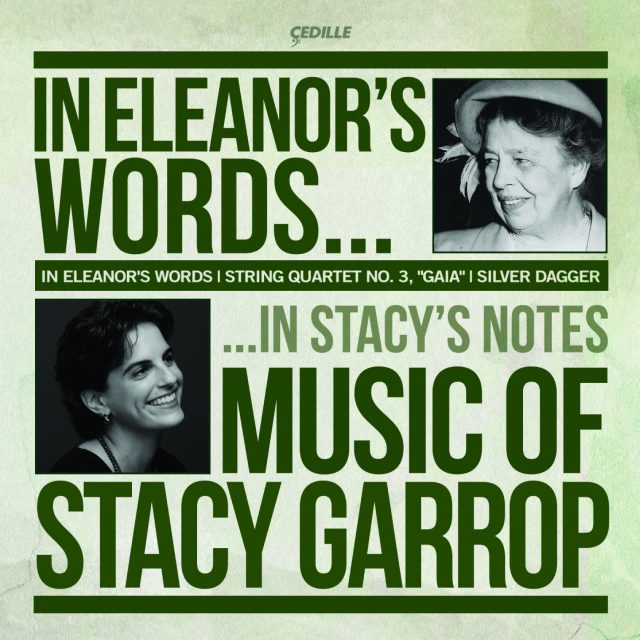
Store
In Eleanor’s Words: Music of Stacy Garrop
Lincoln Trio, Kuang-Hao Huang, Buffy Baggott, Biava Quartet
David Cunliffe, Marta Aznavoorian, Desirée Ruhstrat, Stacy Garrop
In Eleanor’s Words: Music of Stacy Garrop offers world-premiere recordings of three works by “a rising composer who . . . excites the enthusiasm of performers and audiences alike” (Pittsburgh Tribune-Review). A Chicago-based composer with a blossoming career, Garrop (b. 1969) has “a sharp ear for instrumental color and narrative form: She can tell a story” (Detroit Free Press). Writings by the revered American stateswoman and humanitarian Eleanor Roosevelt are the inspiration for Garrop’s In Eleanor’s Words (2006). Scored for mezzo-soprano and piano, the piece illuminates excerpts from six of the former first lady’s syndicated newspaper columns addressing world peace, human rights, and personal experiences. Artists are mezzo-soprano Buffy Baggott and pianist Kuang-Hao Huang. Silver Dagger (2009) for violin, cello, and piano springs from an Appalachian folk song about star-crossed lovers. Garrop skillfully incorporates melodies from three traditional versions of the song in this new work, performed by the Lincoln Trio. Garrop’s much-anticipated String Quartet No. 3, “Gaia” (2008), named for the Greek goddess of the Earth and performed by the Biava Quartet, takes listeners on an engrossing journey from chaos, creation, and abundance to cataclysm and renewal. Garrop’s String Quartet No. 2, “Demons and Angels,” drew praise from, among others, the Milwaukee Journal Sentinel: “Few composers . . . can develop musical ideas as convincingly as Garrop does here.”
Preview Excerpts
In Eleanor’s Words for mezzo-soprano and piano
String Quartet No. 3, "Gaia"
Artists
1: Lincoln Trio
2: Buffy Baggott, mezzo-soprano; Kuang Hao Huang, piano
8: Biava Quartet
Program Notes
Download Album BookletIn Eleanor's Words: Music of Stacy Garrop
Notes by Stacy Garrop
Silver Dagger
At a folk festival in 1994, I heard for the first time an Appalachian folk song called Silver Dagger. The simplicity of the melody joined with a cautionary love tale enthralled me, and I spent the next several years researching the song. What emerged from my research were dozens of variants of the song, in terms of text, melody, and title. These variants could be grouped, more or less, under three different titles: Silver Dagger, Drowsy Sleeper, and Katie Dear. All revolved around the same Romeo and Juliet premise: a boy asks a girl, unsuccessfully, for her parents’ consent to marry. The story has various endings: the parents won’t give approval, so girl and boy end their lives with a silver dagger; the girl turns the boy down and sends him away to find another love; the girl forsakes her parents and runs away with the boy; and so on. In my trio, I incorporate two complete versions of the folk song, one of Katie Dear and one of Silver Dagger, as well as motives from a variant of Drowsy Sleeper.
In Eleanor’s Words
How does one capture the essence of Eleanor Roosevelt in a song cycle? Eleanor served in countless roles throughout her lifetime, including wife, mother, teacher, journalist, First Lady of our country, U.S. delegate to the United Nations, and an ambassador to other nations. She amassed a body of essays, speeches, and letters that convey a portrait of a woman who fought for equality and basic human rights for all people, and whose keen intellect exhibited a deep and concerned understanding of the persons and events that shaped people’s lives right up to her death in 1962. One of her greatest achievements was helping to draft and pass the Universal Declaration of Human Rights as part of her work with the United Nations.
The focal point for this song cycle is her My Day syndicated newspaper column that ran from 1935 until 1962. The column gave Eleanor a means to communicate to Americans across the country about a variety of topics, from tidbits about daily life in the White House to the largest political and social issues of her time. Americans communicated with Eleanor by writing letters to her, many of which she addressed in her columns.
In Eleanor’s Words features excerpts of six columns that present Eleanor Roosevelt in a variety of lights. Arranged in chronological order, these excerpts span from her earliest articles almost to her last. I. The Newspaper Column introduces her byline; in this particular column, she relates a funny situation she finds herself in while trying to meet her article deadline. Her strong feelings about prejudice are expressed in II. Are You Free. In III. An Anonymous Letter, she writes of a friendly communication she received. IV. The Supreme Power gives us a taste of her humor as she and other U.N. General Assembly delegates wrangled over final details of the Universal Declaration of Human Rights. V. The Dove of Peace recounts her trip to Russia during the Cold War. The final movement, VI. What Can One Woman Do? deals with a topic covered in many of her essays and columns: how individuals can make a difference in preventing future wars, particularly after the invention of the atomic bomb. Movements V and VI show Eleanor’s strong belief in particular ideals, even when those ideals were beyond the capabilities of her time. For example, she believed in turning “the weapons of total destruction” over to the United Nations and establishing world law, neither of which has happened.
In Eleanor’s Words (the original version for voice and piano) was commissioned by Thomas J. and Nadine Hamilton through a grant to The Chicago Classical Recording Foundation to honor Marget Hamilton in celebration of her 90th birthday. The piece also exists in a version for voice and large chamber ensemble.
String Quartet No. 3, “Gaia”
Gaia is the mythical Greek goddess of the earth. There is a wide range of stories about Gaia that depict her creations and kindness, as well as her anger and vengeance. I. Gaia is a short introductory movement in which we first encounter Gaia’s theme. In the programmatic II. Creation of Mother Earth, we hear the Greek myth of the planet’s beginnings: from chaos, Gaia emerges in full splendor, then creates the night sky glittering with stars. Gaia and her creations celebrate life in III. Dance of the Earth. In IV. Lamentation, Gaia cries out against humanity’s use and abuse of the planet. This movement combines wailing sirens, S.O.S. distress calls, and the cry of the earth itself, represented by a solo viola. The quartet ends with V. …et in terra pax, which translates to “…and on earth, peace.” This movement represents what so many of us hope and want both in the world and for the planet itself. I envision this as how Gaia began, and to what I hope she can return.
This quartet was commissioned by Thomas J. Hamilton for his wife Nadine. I wanted to embody Nadine in the piece. I did so using the two letters of her name that stand out to my ear – the A and the D. These two notes create the interval of a rising perfect 4th, a bright sound that worked well in my conception of Gaia. I also turned the interval into a simple ascending scale: A B C D. Gaia’s interval, scale, and theme (which emerges in the 1st movement) appear in various guises throughout the entire work.
Texts by Eleanor Roosevelt
All texts are excerpted from Eleanor Roosevelt’s My Day columns, with permission granted by Nancy Roosevelt Ireland, literary executor of Eleanor Roosevelt’s estate.
Most of the sentences below are excerpted in their entirety from their respective columns. There were several cases, however, in which the entire sentence would have been too long to set to music, and thus was shortened to a suitable length. Whenever this was done, the meaning of each sentence was carefully kept intact and not altered. In order to facilitate reading of the excerpted text, I have, in all but one case, left out the usual indicators of missing text.
I. The Newspaper Column
Washington, September 8, 1936. I think people might be amused to know of some of the strange situations in which I have been obliged to write my newspaper column.
One day stands out vividly in my mind. The President was opening Shenandoah Park and we left Washington early in the morning. Mrs. Scheider brought her portable typewriter and came along in one of the White House cars that was going back in the afternoon.
We were busy all the morning. We picnicked for lunch, and the President made his speech at about 3 o’clock in the afternoon. I had told him beforehand that as soon as he had finished speaking, I would dash for the other car and the typewriter, and would he please wait for me before proceeding to Richmond.
He was most reassuring. I made my way to the car.
Mrs. Scheider was there with the typewriter already opened on the little seat in front of her. We no sooner began to work than people came up to the car and said, “I just wanted to shake hands, Mrs. Roosevelt,” or, “My little girl would be so happy if I could have your autograph.”
In desperation I beckoned to the chauffeur and one of the Secret Service men standing near and begged them to stand on either side of the car until I was finished.
In about one minute Mr. MacIntyre, the President’s secretary, came along and put his head inside one of the windows. My heart sank.
“Oh, is the President ready so soon?” I asked.
To which he responded: “Oh no, he is talking to the Governor and is entirely happy, having already announced that, having a wife who is a columnist, he has to wait for her occasionally. I just thought I would like to see you work.”
II. Are You Free
New York, December 8, 1938. As I listened to the speeches last night, I could not help thinking how much all human beings like to fool themselves.
Mr. William Green, President of the American Federation of Labor, told me of his son practicing law, and how he had been able to give him and his five sisters college educations when he had had to leave school and spend twenty years in the mines. Natural enough that he should feel that this is a grand country. He knows that some things are not just as we might wish, but nevertheless this is the land of the free. He told us this in his speech and that we can pat ourselves on the back that we are lucky enough to live here.
Almost every other speaker gave us the same kind of pat and made us feel more virtuous and fortunate than any other people in the world. While I listened, I could not help thinking of some of the letters that pass through my hands.
Are you free if you cannot vote, if you cannot be sure that the same justice will be meted out to you as to your neighbor, if you are expected to work for lower wages, if you are barred from certain places and from certain opportunities?
Are you free when you can’t earn enough, no matter how hard you work, to feed and clothe and house your children properly?
There are lots and lots of things that make me wonder whether we ever look ourselves straight in the face and really mean what we say when we are patting ourselves on the back.
Somewhere someone must have a quiet laugh, if there is a place where real truth is dealt in.
III. An Anonymous Letter
Westbrook, Connecticut, October 30, 1944. I can hardly believe it, but I have received an anonymous letter which says nothing but pleasant things. That has never happened to me before. Both the letter and the verse accompanying it are very kindly meant, and certainly helped to do the thing the writer wished to do. She says: “Even Mrs. Roosevelt must need morale lifting too.”
Sometimes I do, so many thanks to an unknown friend.
IV. The Supreme Power
Paris, December 10, 1948. I would have been delighted to see in the preamble a paragraph alluding to the Supreme Power. I knew very well, however, there were many men around the table who would violently be opposed to naming God, and I did not want it put to a [roll call] because I thought for those of us who are Christians it would be rather difficult to have God defeated in a vote.
V. The Dove of Peace
New York, October 2, 1957. What is the Soviet Union really like? It is a mass of contradictions and it takes study and thought to understand it.
There is one symbol — the dove of peace — that you meet practically everywhere in Russia. I saw it painted on the side of truck; I looked down on it outlined in stone below me. A circus I attended ended with the release of doves of peace. Everywhere this seems to be the symbol.
You might think that it was an effort to keep the people reminded of their need for peace. Heaven knows they don’t need a reminder! They suffered enough in the war.
It is done to remind the people that they must sacrifice and work for peace because their great enemy, the United States, is trying to bring about a war.
The Soviet government is only trying to protect the people from such aggression.
If you forget this, you will be lulled into a security that is dangerous for all of us. But you are going to need much more understanding, much more willingness to learn before you can hope to avoid this war that these people are being indoctrinated into believing that we might start.
Guns and atomic weapons are not going to win this war or prevent it. Much, much more has to be done, and to explain why I say this, I am going to tell you about what the Soviet Union is today.…
On this understanding alone, I believe, can we form a policy which may save us from the war that the people of the Soviet Union dread as much as we do.
VI. What Can One Woman Do?
New York, December 20, 1961. What can one woman do to prevent war? This is the question that comes my way in any number of letters these days.
For many years war has been looked upon as almost inevitable in the solution of any question that has arisen between nations, and the nation that was strong enough to do so went about building up its defenses and its power to attack. It felt that it could count on these two things for safety.
There was a point then in increasing a nation’s birth rate: Providing more soldiers. There was a point in creating new weapons: At their worst, they could not destroy the world as a whole.
Now, all a citizen can do is watch his government use its scientists to invent more powerful ways of achieving world destruction more and more quickly.
As I travel around this country I cannot help thinking what a pity it would be to destroy so much beauty, and I am sure this thought crosses the mind of many a Russian traveling through his country.
To the women and the men asking themselves, “What can I do as an individual?” my answer is this: Take a more active interest in your government, have a say in who is nominated, work for these candidates and keep in close touch with them if they are elected.
If our objective is to do away with the causes of war, build up the United Nations and give the UN more control over the weapons of total destruction, we should urge that world law be developed so that people’s grievances can be heard promptly and judiciously settled.
We should begin in our own environment and in our own community to build a peace-loving attitude and learn to discipline ourselves to accept, in the small things of our lives, mediation and arbitration.
No citizen of a democracy need feel completely helpless if he becomes an active factor in the citizenship of his community.
As long as we are not actually destroyed, we can work to gain greater understanding of other peoples and to try to present to the peoples of the world the values of our own beliefs.
Album Details
Total Time: 67:30
Producer: James Ginsburg
Engineer: Bill Maylone
“Gaia” first edit: Jeanne Velonis
Recorded: November 30, 2009 (Silver Dagger); December 4 and 6, 2009 (In Eleanor’s Words); and February 3 and 5, 2010 (String Quartet No. 3, “Gaia”) in the Fay and Daniel Levin Performance Studio, WFMT, Chicago
Steinway Piano, Piano Technician: Charles Terr
Art Direction: Adam Fleishman – www.adamfleishman.com
Front Cover Photos: Franklin D. Roosevelt Presidential Library (Eleanor Roosevelt) and Bill Burlingham (Stacy Garrop)
All works published by Theodore Presser Company:
Silver Dagger ©2010; In Eleanor’s Words ©2009; String Quartet No. 3, “Gaia” ©2010Total Time (67:30)
© 2010 Cedille Records/Cedille Chicago
CDR 90000 122
